

Fractional reserve banking. Fractional-reserve banking is the practice whereby a bank holds reserves in an amount equal to only a portion of the amount of its customers' deposits to satisfy potential demands for withdrawals.
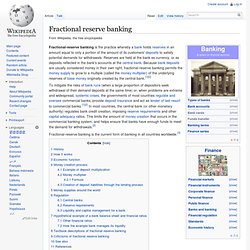
Reserves are held at the bank as currency, or as deposits reflected in the bank's accounts at the central bank. Because bank deposits are usually considered money in their own right, fractional-reserve banking permits the money supply to grow to a multiple (called the money multiplier) of the underlying reserves of base money originally created by the central bank.[1][2] Fractional-reserve banking is the current form of banking in all countries worldwide.[3] History[edit] Fractional-reserve banking predates the existence of governmental monetary authorities and originated many centuries ago in bankers' realization that generally not all depositors demand payment at the same time.[4]
Demand deposit. Demand deposits, bank money or scriptural money[1] are funds held in demand deposit accounts in commercial banks.[2] These account balances are usually considered money and form the greater part of the narrowly defined money supply of a country.[3] History[edit] In the United States, demand deposits arose following the 1865 tax of 10% on the issuance of state bank notes; see history of banking in the USA.
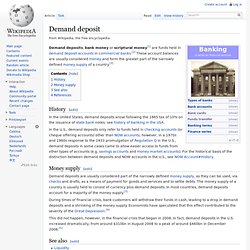
In the U.S., demand deposits only refer to funds held in checking accounts (or cheque offering accounts) other than NOW accounts; however, in a 1970s and 1980s response to the 1933 promulgation of Regulation Q in the U.S., demand deposits in some cases came to allow easier access to funds from other types of accounts (e.g. savings accounts and money market accounts). For the historical basis of the distinction between demand deposits and NOW accounts in the U.S., see NOW Account#History. Bank run. Depositors clamor to withdraw their savings from a bank in Berlin, 13 July 1931 A bank run (also known as a run on the bank) occurs in a fractional reserve banking system when a large number of customers withdraw their deposits from a financial institution at the same time and either demand cash or transfer those funds into government bonds, precious metals or stones, or a safer institution because they believe that the financial institution is, or might become, insolvent.
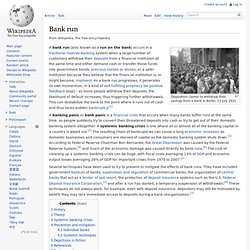
As a bank run progresses, it generates its own momentum, in a kind of self-fulfilling prophecy (or positive feedback loop) – as more people withdraw their deposits, the likelihood of default increases, thus triggering further withdrawals. This can destabilize the bank to the point where it runs out of cash and thus faces sudden bankruptcy.[1] Several techniques have been used to try to prevent or mitigate the effects of bank runs. 1907 : un « bank run » fondateur aux Etats-Unis. La panique bancaire, c'est à l'heure actuelle ce que cherchent à éviter les autorités chypriotes et européennes en repoussant de jour en jour la réouverture des établissements bancaires de l'île.
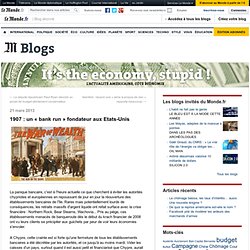
Rares mais potentiellement lourds de conséquences, les retraits massifs d'argent liquide ont refait surface avec la crise financière : Northern Rock, Bear Stearns, Wachovia... Pris au piège, ces établissements menacés de banqueroute dès le début du krach financier de 2008 ont vu leurs clients se précipiter aux guichets par peur de voir leurs économies s'envoler. Nash equilibrium. In game theory, the Nash equilibrium is a solution concept of a non-cooperative game involving two or more players, in which each player is assumed to know the equilibrium strategies of the other players, and no player has anything to gain by changing only their own strategy.[1] If each player has chosen a strategy and no player can benefit by changing strategies while the other players keep theirs unchanged, then the current set of strategy choices and the corresponding payoffs constitutes a Nash equilibrium.
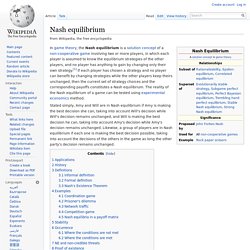
The reality of the Nash equilibrium of a game can be tested using experimental economics method. Stated simply, Amy and Will are in Nash equilibrium if Amy is making the best decision she can, taking into account Will's decision while Will's decision remains unchanged, and Will is making the best decision he can, taking into account Amy's decision while Amy's decision remains unchanged. Bankruptcy. Notice of closure attached to the door of a Computer Shop outlet the day after its parent company declared "bankruptcy" (strictly, put into administration) in the United Kingdom Bankruptcy is a legal status of a person or other entity that cannot repay the debts it owes to creditors.

In most jurisdictions, bankruptcy is imposed by a court order, often initiated by the debtor. Systemic risk. Cascading failure. An animation demonstrating how a single failure may result in other failures throughout a network.
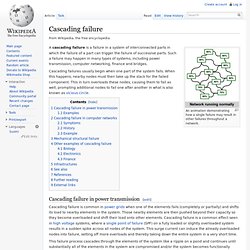
A cascading failure is a failure in a system of interconnected parts in which the failure of a part can trigger the failure of successive parts. Such a failure may happen in many types of systems, including power transmission, computer networking, finance and bridges. Cascading failures usually begin when one part of the system fails.
When this happens, nearby nodes must then take up the slack for the failed component. This in turn overloads these nodes, causing them to fail as well, prompting additional nodes to fail one after another in what is also known as vicious circle.
Milton Friedman. Un article de Wikipédia, l'encyclopédie libre.

Pour les articles homonymes, voir Friedman. Photographie représentant Milton Friedman. Droite Libertarienne Québécoise. Ayn Rand. Un article de Wikipédia, l'encyclopédie libre.
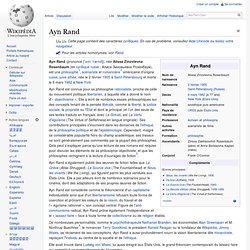
Pour les articles homonymes, voir Rand. Ayn Rand (prononcé [ˈaɪn ˈrænd]), née Alissa Zinovievna Rosenbaum (en cyrillique russe : Алиса Зиновьевна Розенбаум), est une philosophe[1], scénariste et romancière[2] américaine d'origine russe, juive athée, née le 2 février 1905 à Saint-Pétersbourg et morte le 6 mars 1982 à New York. Ayn Rand est considérée comme la théoricienne d'un capitalisme individualiste ainsi que d'un libertarianisme refusant toute forme de coercition et prônant les valeurs de la raison, du travail et de l'« égoïsme rationnel », son concept central. Figure de l'anti-communisme radical, Ayn Rand prône également l'indépendance et le « laissez-faire » face à toute forme de collectivisme ou de religion établis. De nombreuses personnalités, comme le psychothérapeute Nathaniel Branden, les économistes Alan Greenspan et M.
Tea Party (mouvement politique) Alan Greenspan. Margin (finance) Margin buying refers to the buying of securities with cash borrowed from a broker, using other securities as collateral.

This has the effect of magnifying any profit or loss made on the securities. The securities serve as collateral for the loan. Derivative (finance) Many money managers use derivatives for a variety of purposes, such as hedging — by taking a position in a derivative, losses on portfolio holdings may be minimized or offset by profits on the derivative. Likewise, derivatives can be used to gain quicker and more efficient access to markets; for example, it may be easier and quicker to purchase an S & P 500 futures contract than to invest in the underlying securities.[3] Derivatives are a contract between two parties that specify conditions (especially the dates, resulting values and definitions of the underlying variables, the parties' contractual obligations, and the notional amount) under which payments are to be made between the parties.[4][5] The most common underlying assets include commodities, stocks, bonds, interest rates and currencies, but they can also be other derivatives, which adds another layer of complexity to proper valuation.
Still, even these scaled down figures represent huge amounts of money.